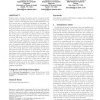Free Online Productivity Tools
i2Speak
i2Symbol
i2OCR
iTex2Img
iWeb2Print
iWeb2Shot
i2Type
iPdf2Split
iPdf2Merge
i2Bopomofo
i2Arabic
i2Style
i2Image
i2PDF
iLatex2Rtf
Sci2ools
KDD
2006
ACM
2006
ACM
Adaptive Website Design Using Caching Algorithms
Visitors enter a website through a variety of means, including web searches, links from other sites, and personal bookmarks. In some cases the first page loaded satisfies the visitor's needs and no additional navigation is necessary. In other cases, however, the visitor is better served by content located elsewhere on the site found by navigating links. If the path between a user's current location and his eventual goal is circuitous, then the user may never reach that goal or will have to exert considerable effort to reach it. By mining site access logs, we can draw conclusions of the form "users who load page p are likely to later load page q." If there is no direct link from p to q, then it would be advantageous to provide one. The process of providing links to users' eventual goals while skipping over the in-between pages is called shortcutting. Existing algorithms for shortcutting require substantial offline training, which make them unable to adapt when ...
| Added | 30 Nov 2009 |
| Updated | 30 Nov 2009 |
| Type | Conference |
| Year | 2006 |
| Where | KDD |
| Authors | Justin Brickell, Inderjit S. Dhillon, Dharmendra S. Modha |
Comments (0)

